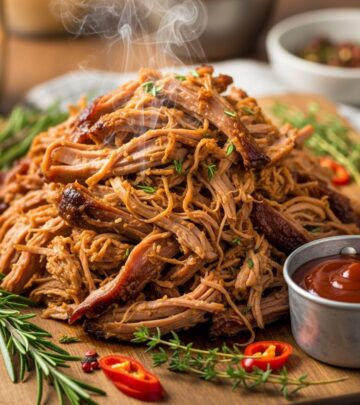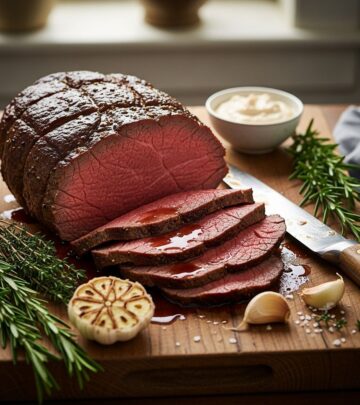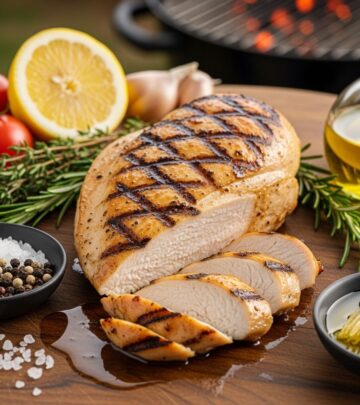Niter Kibbeh: The Essential Ethiopian Spiced Butter
A subtly complex infusion that enriches stews, sautés, and simple grains alike.

Niter Kibbeh: Ethiopia’s Essential Spiced Clarified Butter
Niter kibbeh is a fragrant clarified butter infused with a blend of spices and aromatics that forms the foundation of many dishes in Ethiopian and Eritrean cuisine. Revered for its depth, complexity, and versatility, it’s much more than just a cooking medium—every spoonful bathes food in layers of warm, earthy, and subtly sweet flavors. Let’s explore its history, the ingredients that set it apart, how to make it at home, and the myriad ways it elevates cooking.
What Is Niter Kibbeh?
Niter kibbeh (pronounced NIT-r KEB-beh) is a clarified butter, similar in some respects to ghee, but distinguished by its infusion of spices, herbs, and aromatics. Unlike ghee or other clarified butters, niter kibbeh builds flavor profiles that are at once ethereal and robust. Its value in East African cooking is difficult to overstate—it enriches stews, sautés, sauces, and even vegetables with its heady aroma.
Understanding Its Place In Ethiopian Cooking
- Foundation for Flavors: Used as the base for classic Ethiopian dishes like wots (stews) and tibs (sautéed meat dishes).
- Versatility: Adds depth to vegetarian curries, makes sauces more luxurious, and transforms even simple grains or breads.
- Preservation: The clarifying process and added spices help niter kibbeh stay fresh for months when refrigerated or frozen.
The History and Origins of Niter Kibbeh
Niter kibbeh hails from both Ethiopian and Eritrean culinary traditions, tracing back centuries as a core ingredient in their respective food cultures. Eritrea, once a part of Ethiopia, shares much of its cooking repertoire, and niter kibbeh’s role as a flavor-packed fat is a prime example of this overlap.
- Tradition: Recipes for niter kibbeh vary from household to household, much like curries or pasta sauces, with each cook using their preferred blend of spices.
- Regional Variants: Some regions might insist on certain spices or herbs—reflecting the diversity and adaptability of Ethiopian cuisine.
- Cultural Importance: Making niter kibbeh is often an event in itself, signaling care and attention that goes into preparing traditional meals.
Ingredients: What Makes Niter Kibbeh Unique?
The magic of niter kibbeh lies in its carefully balanced mix of butter and aromatic ingredients. While every family recipe is different, common ingredients provide the bold, distinctive character everyone associates with Ethiopian cooking.
| Ingredient | Role in Flavor |
|---|---|
| Unsalted Butter | Rich, creamy base for absorbing and carrying spices |
| Minced Shallots | Sweet, aromatic undertone |
| Garlic | Savory depth |
| Fresh Ginger | Earthy, peppery brightness |
| Cardamom Pods | Warm, citrusy and floral notes |
| Cloves | Subtle sweetness; spicy warmth |
| Cinnamon Stick | Sweetness; comforting aroma |
| Dried Oregano | Herbal depth |
| Ground Turmeric | Golden color and gentle bitterness |
| Ground Fenugreek | Sweetness; nutty complexity |
Optional Variations
- Duck fat or lard can replace butter for a robust, gamey flavor.
- Vegan alternatives such as coconut or vegetable oil may be used, though the classic flavor is richest with butter.
How to Make Niter Kibbeh
Making niter kibbeh is a gentle process that requires patience and precision. The key is to infuse the butter slowly, allowing every nuance of spice and aroma to develop while clarifying the fat. Here’s a comprehensive, step-by-step guide:
Essential Equipment
- Heavy-bottomed pot or saucepan
- Cheesecloth for straining
- Spatula (preferably heat resistant)
- Glass jar for storage
Ingredients
- 1 lb (454 g) unsalted butter
- 2 shallots, minced (about 1/4 cup)
- 2 cloves garlic, minced
- 2 tbsp minced fresh ginger
- 12–15 cardamom pods, crushed
- 5 whole cloves
- 1 cinnamon stick (about 1 inch)
- 1 tbsp dried oregano (or Ethiopian besobela)
- 1/2 tsp ground turmeric
- 1 tsp ground fenugreek
Step-by-Step Instructions
- Toast Spices: Dry roast the cardamom pods, cloves, and cinnamon stick in a skillet over medium heat for about a minute, until aromatic—but do not burn.
- Cube Butter: Cut the butter into pieces so it melts evenly.
- Combine Ingredients: Add butter, toasted spices, shallots, garlic, ginger, oregano, turmeric, and fenugreek to the heavy pot.
- Slow Simmer: Bring the mixture to a low simmer (never boiling). Let it cook very gently for at least 30 minutes, but ideally closer to an hour.
- Monitor Closely: Watch the milk solids—they should never brown. If you notice browning, immediately remove the pot from heat.
- Strain Carefully: When the butter is infused and clarified, pour it through cheesecloth into a clean glass jar; discard solids.
- Store Properly: Keep niter kibbeh refrigerated for up to 6 months, on the counter for about a week, or freeze for later use.
Quick Notes & Tips
- This recipe yields roughly 2 cups of niter kibbeh.
- Avoid burning milk solids—they’ll impart bitterness and ruin the subtle flavors.
- Feel free to experiment with storied family spice blends.
Nutrition Information
| Nutrient | Per 1 oz (approx.) |
|---|---|
| Calories | 214 kcal |
| Carbohydrates | 2 g |
| Protein | 1 g |
| Fat | 23 g |
| Saturated Fat | 15 g |
| Cholesterol | 61 mg |
| Sodium | 4 mg |
| Potassium | 42 mg |
| Fiber | 1 g |
| Sugar | 1 g |
| Vitamin A | 714 IU |
| Vitamin C | 1 mg |
| Calcium | 22 mg |
| Iron | 1 mg |
Nutrition facts are approximate and may vary depending on ingredients and batch.
How to Use Niter Kibbeh
Niter kibbeh is much more than a finishing touch. It forms the backbone of some of Ethiopia’s signature dishes and can be creatively substituted for other fats in a wide range of recipes.
Classic Ethiopian Dishes Featuring Niter Kibbeh
- Alicha Wot: Gentle, curry-like stew, ideal for lamb, beef, goat, or venison. Niter kibbeh imparts color and rich spice.
- Tibs: A quick stir-fry/stew of tender meats. Niter kibbeh gives savory, layered flavor and succulent texture.
- Abish Wot: Beef or lamb stew, highlighted by fenugreek, enhanced by a spoonful of niter kibbeh.
- Vegetarian Dishes: Butternut squash curry and other meatless stews are transformed by its aromatic fat.
Creative Kitchen Applications
- Searing: Poach or sear fish fillets, white poultry, or even vegetables in niter kibbeh for an exotic boost.
- Enriching Stews: Add a spoonful to bean or grain stews, sautéed greens, or even simple rice for complexity.
- Baking: Try it in savory breads or pastries in place of regular clarified butter or ghee.
Storage and Shelf Life
- Refrigeration: Up to 6 months in a tightly sealed container.
- Freezing: Indefinitely; portion into small jars for convenience.
- Counter Storage: Up to 1 week, protected from heat and sunlight.
Always use a clean utensil to remove niter kibbeh to prevent cross-contamination and prolong shelf life.
Frequently Asked Questions (FAQs)
Q: Can niter kibbeh be made dairy-free?
A: Yes. Substitute the butter with coconut oil or vegetable oil. While this alters the signature richness, the spiced profile remains aromatic and delicious.
Q: What is the difference between niter kibbeh and ghee?
A: Ghee is clarified butter, typically made by simmering and straining milk solids. Niter kibbeh includes a complex blend of spices and aromatics, resulting in a much more nuanced and robust flavor.
Q: Can I use salted butter?
A: Unsalted butter is preferred for niter kibbeh, as it offers better control over seasoning and prevents unwanted salty notes from dominating the spice blend.
Q: Which spices are non-negotiable?
A: Shallots (or onions), cardamom, fenugreek, and turmeric form the essential backbone of niter kibbeh’s flavor, though other ingredients may be adjusted to taste.
Q: Is niter kibbeh used in Eritrean cuisine?
A: Absolutely. Eritrea’s culinary traditions overlap closely with Ethiopian techniques—niter kibbeh appears in numerous classic Eritrean dishes.
Expert Tips for Perfect Niter Kibbeh
- Infuse on low heat. High temperatures risk burning the milk solids and spoiling delicate flavors.
- Choose fresh, high-quality spices for optimal taste and aroma.
- Strain thoroughly to yield a clear, golden fat packed with aromatic compounds.
- Let your niter kibbeh cool before sealing or freezing, which preserves flavor and clarity.
- Experiment with spice ratios—and don’t forget: every cook’s niter kibbeh is unique.
Serving Suggestions
- As a drizzle over grilled meats or vegetables
- Mixed into cooked grains, lentils, or beans
- Brushed on injera (Ethiopian flatbread) for extra richness
Variations and Innovations
While niter kibbeh is classically made with butter, it’s a forgiving technique amenable to many flavorful fats. Duck fat imparts a decadent richness, while lard lends a hint of porky savor. Cooks seeking vegan alternatives use coconut oil for a sweet undertone or vegetable oil for a more neutral taste. Always adjust quantities or spice balance to suit the chosen medium.
Experience the Soul of Ethiopian Cooking
Niter kibbeh is more than an ingredient—it’s an invitation to immerse yourself in the traditions, warmth, and aromatic splendor of East Africa. Whether you’re a seasoned fan of Ethiopian cuisine or a newcomer, a batch of niter kibbeh unlocks a world of culinary possibility. With patience and a handful of pantry spices, you’ll be stirring up dishes that are rich, inviting, and deeply memorable.
Read full bio of Sneha Tete












